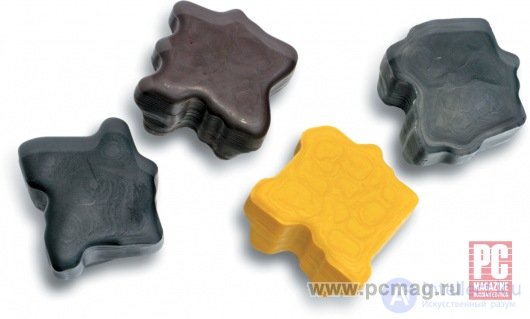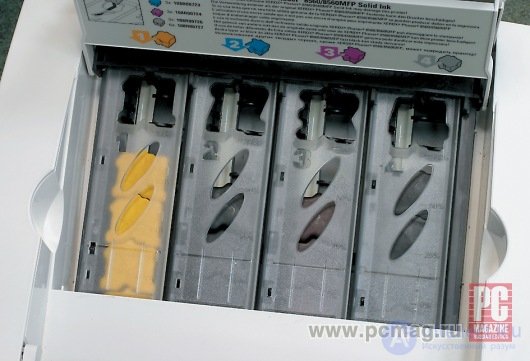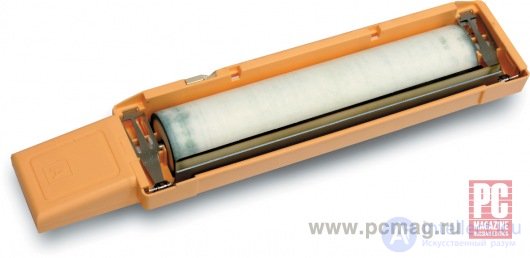Lecture
Solid ink printing technology was invented in 1986 in the company Tektronix, primarily for the needs of publishing houses and printing. Launched in 1991, the company's first hard-ink printer, the Phaser III, cost about $ 10,000 and was intended primarily for the manufacture of printing color proofs. Further improvement of technology has improved the quality of printing and bring the price of printers to values acceptable for ordinary office printing. After acquiring Tektronix’s printer unit in 2000 by Xerox, this trend continues to grow. It is important that, in contrast to the laser, the hard-ink technology was initially focused on color rather than black-and-white printing. In fact, it is closer to the jet, but with laser and even offset elements: the heads of the molten dyes ejected by the nozzles do not fall directly on the paper, but first on the heated metal drum, from which they are transferred to the paper, where they freeze. This achieves, on the one hand, high print speed inherent in laser printers, and on the other hand, the quality of image output approaching offset printing.
\
Operating principle Slideshow (6) Slideshow | All photos “Ink” in the initial state are small bars of wax-like composition mixed with the dye of one of the four main printing colors - cyan, magenta, yellow and black (CMYK). Note that the colors of the bars are not very similar to those obtained after their melting - so, the "blue" bar looks dark blue (almost black), and the "purple" - dark brown. The bar of each color has a unique (distinguishing it not only from the bars of other colors, but also from the bars for other models of hard-ink printers) a bizarre shape corresponding to the shape of the hole in the dedicated ink container compartment. Such a “form encoding” almost completely eliminates the possibility of an error when refilling the printer with ink. Up to four bars are “charged” to each compartment, and they can be added at any time, including during the printing process. When closing the lid of the container, the bars are pressed with springs so that the head bar in each compartment is pressed tightly against the ceramic melting plate. The melted hot plates of the ink flow into the heated reservoirs of the printhead, where they are maintained in the molten state. After filling the tank of a certain color, the corresponding melting plate is turned off. As ink is consumed, the plates turn on, maintaining the required level of dyes in the reservoirs of the head. The stainless steel piezo jet head has 1236 nozzles and, unlike the inkjet printer heads, covers the entire width of the printed page. The resolution of 2400 dpi, achieved in modern models of hard-ink printers, is ensured by a small (by the distance between adjacent nozzles) horizontal displacement of the head. Piezo nozzle able to emit up to 30 million. Drops per second. Thanks to this design, a much higher print speed than inkjet printers is achieved (up to 30 ppm). Drops of dyes ejected by the head fall on a rotating stainless steel drum heated to a temperature less than the head, which is preliminarily applied with a special roller included in the maintenance kit to apply a thin layer of silicone oil. On the drum, the dyes pass from the liquid to the intermediate elastic state. When about a third of the page image is formed on the drum, a sheet of paper (or other media) is fed from the lower cassette or multifunctional front tray. After passing through the slit of the heater, the heated sheet is pressed by the transfer roller to the drum, and dyes with greater adhesion to the paper than to the oiled smooth drum are transferred to the sheet, where they finally solidify. The scraper included in the maintenance kit cleans the drum from dirt and droplets of dyes remaining on it, after which the process is repeated. As you can see, the printing technology is practically wasteless. However, the figure shows a node about which nothing has been said so far - a waste tray. Where do they come from? Waste arises in the process of preparing the printer for operation from a cold (i.e., completely off) state. One of the stages of this long (up to 15 min) process is the vacuum cleaning of the nozzles of the head, during which part of the melted ink is drained into the waste container and freezes there. That is why it is recommended not to turn off the solid ink printer. With frequent shutdowns, quite a noticeable part of the dyes can go to waste, so in case of unstable power supply, you should consider purchasing a separate UPS for the printer. The printer controller (in the latest Xerox models it is based on the PowerPC 600-MHz RISC processor) provides image rasterization (the main page description language is PostScript 3, PCL5c can also be emulated) and control of the printing mechanism. The control panel, printer driver, and PC communication interfaces are not much different from laser models.
Advantages Slideshow (6) Slideshow | All photos The solid ink printer has a number of indisputable advantages over color laser. As already mentioned, they are largely due to the fact that the solid ink technology was originally developed with an eye to color printing, whereas a color laser printer is actually four monochrome ones in one package. The main advantage of a hard-ink printer is a much simpler design, a disproportionately smaller number of mechanical, optical and electronic components, and consequently, higher reliability. There is neither a precision optical-mechanical system for scanning the laser beam, nor photoreceptors, nor blocks of development and thermal fixation of the image. If a laser printer (even monochrome), which has spent its entire life with a nominal load and has never been repaired, is almost impossible to find, then for a solid-ink printer, provided it is properly used, this situation is quite real. The second important advantage is a much smaller amount of consumables and the simplicity of adding and replacing them. There are only two such materials - ink bars and a maintenance kit. The ink is in a solid state, does not stain hands and clothes, it is extremely easy to add - even a child is able to do it. Solid ink technology is also unique in the sense that it is possible to add dyes without interrupting the printing process. Replacing a maintenance kit is also a simple operation that takes less than a minute. The third, also important, advantage is a stable print quality that does not change with time and is independent of the number of pages printed on the printer. Virtually all color laser printers as print drums, transfer rollers and other parts wear, print quality deteriorates markedly. With regard to print quality, bright, vibrant colors can be noted, which only high-end color laser printers, which are several times more hard-ink, or inkjet models when printing on paper with a special coating, can boast. The advantage of a solid ink printer over the latter is the absence of ink spreading on any type of paper, even newsprint. Completely absent in many laser (and some inkjet) printers "banding". Prints are water resistant. Not the last value has a high print speed (up to 30 ppm), peculiar only to much more expensive models of color laser printers, whereas the cost of a solid ink printer is close to the cost of a monochrome network laser printer of similar performance. Such a short time for the first page to be released - 5 seconds - a record value not only for color, but also for monochrome laser models. In laser printers to achieve maximum printing speed, as a rule, there are two sheets in the paper path at the same time, which accounts for most of the problems with paper jams. In a hard-ink printer, the feeding of the next sheet always begins only after the previous one is completely out. Thanks to a simpler supply path, hard-ink printers can print on denser media than most laser printers - up to 220 g / m2. They have no problems with printing on a variety of media - recycled paper, envelopes, transparencies, media that are not uniform in thickness and type of materials (for example, envelopes with a transparent window). Due to the lack of fusing toner for solid ink printing, you can use media that are more sensitive to high temperature than laser. Finally, last in order, but not the least important for all who are concerned about the environment, the advantage is 90% less than that of laser printers, the amount of waste. For clarity, these figures can be cited: after printing 100 thousand sheets on a color laser printer of a similar class, the HP LaserJet 4700 produces 71 kg of waste, while on a hard-ink Xerox Phaser 8560 - only 2 kg.
Disadvantages Slideshow (6) Slideshow | All photos As often happens, the disadvantages of solid ink printing technology are the other side of its advantages. First of all, they are due to the fact that the ink is at a solid state at room temperature, and the constant readiness of the printer for printing involves maintaining them in the molten form. The biggest drawback is that the “cold start” is very long compared to other types of printers (in the first Tektronix samples, the initial launch time reached 45 minutes, in modern models it is reduced to 12–15 minutes) - it will not be very noticeable if you never turn off printer off the network. At the same time, the second drawback is leveled - a significant ink consumption for the initial launch. Even if the printer does not turn off completely, but is in an energy-saving state (note that this concept itself has a slightly different meaning for solid-ink printers than for laser printers - if for the latter the consumption in this mode is usually less than 20-40 W, then for the former it is more 200 W), the time of its preparation for work after the arrival of the print job is 4–5 minutes. It is clear that in most office applications such a delay is unacceptable, therefore special methods are used to ensure constant printer availability — automatic on and off on a schedule, and even automatic tracking of “printed” employee behavior and turning on the printer shortly before the start of activity periods (on and off) transfer to active and energy-saving modes, respectively). Now about prints. Their main drawback is low mechanical strength (solid color fillings are easily scratched with a fingernail). The obvious way to protect important documents is lamination, but even here pitfalls are lurking — thin lines and small fonts blur slightly due to the heat in the laminator. Another drawback is the lack of mixing and spreading ink on paper and the low density of nozzles in the head. As a result, on the light areas of the photographic images, there is a noticeable "nifty". This disadvantage makes it practically impossible to use a printer for high-quality photo printing. His element is text and business graphics with not too thin lines and solid color fills.
Economic indicators Slideshow (6) Slideshow | All photos As you know, the most important technical and economic indicator of a printer for medium-sized workgroups (namely, Xerox hard-ink models belong to this category) is the total cost of ownership (TCO) calculated taking into account all the costs over the life of the printer. We will try to estimate this indicator tentatively for laser and hard-ink printers with close performance and maximum monthly load - Xerox Phaser 6360DN and Xerox Phaser 8560DN. In this case, we will not take into account the cost of repair and maintenance of devices, which, in view of the above, will play into the hands of a laser printer. We will not take into account the cost of electricity - there is already winning solid carbide machine. Let us build on a realistic estimate for the printers of this class of estimating the average number of color pages printed over the entire service life (with a 5 percent fill in each of the four colors) - 300 thousand. The amount of consumables of each type was calculated by dividing this figure by rounding up. As you can see, at a total cost of ownership, a hard-ink printer even surpasses a laser. The added economic advantage of a solid ink printer is less downtime due to repairs and lower maintenance and repair costs. 


Comments
To leave a comment
Electromechanical devices of electronic devices
Terms: Electromechanical devices of electronic devices